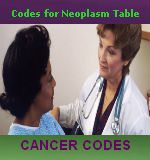The basics of the codes for neoplasm table are easy to remember once you have worked with it a few times. Ask yourself these three questions before you start:
1) What body part is being affected by the neoplasm?
The neoplasm table is divided up anatomically and alphabetically. If you know the anatomical site of the neoplasm, such as the lung, then you are ready to get started. To locate a neoplasm of the lung you look it up alphabetically like you would a word in a dictionary. It is important to code to the highest specificity. Therefore, if you know more information than “the neoplasm is located in the lung,” you can adjust your coding accordingly. Your documentation might identify the neoplasm at the upper lobe of the lung, which would bring you to 162.3 versus 162.9, which reveals it is in the lung but not specified where.
2) Has the type of neoplasm been identified?
Now that you know where the neoplasm is located and have a starting point with the table, it is time to determine through the documentation you are given what type of neoplasm you are dealing with. There are three major types of neoplasm and are listed at the top of the table. These are malignant, benign, and cancer in situ. When malignant is stated, that tells you the neoplasm is cancerous. The best description of a malignant neoplasm I have ever heard was that it is ambitious. Malignant neoplasms like to move. They have two goals: to survive and to conquer new territory. You may have heard of world domination. Think of a malignancy as wanting body domination. It will start with one organ and work until it has moved on to another. So when you are thinking of malignancy, think fast and on the move. This is also referred to as metastases or metastasizing. Metastasis means one tumor, and metastases is the plural, which means more than one tumor. In addition, malignant cancers are often recognized by the suffix used. Carcinoma, as in Adenocarcinoma, or sarcoma, as in Leiomyosarcoma, tells you these are malignant cancers.
Codes for Neoplasm Table
The term benign refers to a neoplasm that is slow, does not come back and does not move to other locations. It is a mass of tissue that has no purpose in life and takes up space, often at the expense of good organ tissue. Colon polyps are an example of benign tissue. They develop and can cause problems like bleeding and need to be removed. If a benign neoplasm is located in a space that prevents an organ from working properly, it also would need to be removed. After removal, routine follow-up is all that is needed, unlike having a malignant neoplasm.
The least known of the neoplasms is Cancer in Situ (CIS). This is when you have a group of cancer cells surviving in the body encapsulated together but not invading an organ. Think of it as a jelly bean of cancer cells sitting in an organ. A common form of CIS is ductal carcinoma in situ (DCIS). The cancer cells are located in the milk duct of the breast. This is not life threatening but could develop into invasive breast cancer. In the case of DCIS you would code 233.0 Carcinoma in situ of the breast.
3) Has there been a neoplasm before?
In order to code to the highest specificity, the neoplasm table allows you to identify whether or not this is the first neoplasm to be found. The terms used are easy to follow. Primary neoplasm is the first cancer and secondary is where the cancer has spread. If your patient has 162.3 cancer, upper lobe of the lung, and metastases to the liver, 197.7 is your secondary location and code. In plain English, this states that there is lung cancer that has now moved on to the liver. Cancer does move fast but can take a long time to show up. If the patient had 162.3 ten years ago and is in remission, but is seen for abdominal pain and it is determined that there is now cancer of the liver, you would still use the 197.7 code as a secondary code because it is not the first time the patient has had cancer.
Using the neoplasm table can speed up the coding process, and with a little practice it becomes second nature to use. When you know what organ is affected, the type of neoplasm, and if it is the only cancer, the other guidelines will fall into place. If you want to get more out of the neoplasm table, be sure your anatomy and terminology skills are up-to-date. The basics of the neoplasm table will help you as you learn medical coding.
More Codes for Neoplasm Table Related Posts:
Medical Coding Continuing Education
AAPC – Sequence Coding for Neoplasms
![[CCO] Certification Coaching Organization LLC [CCO] Certification Coaching Organization LLC](https://www.cco.us/wp-content/uploads/2015/05/CCO-Logo-2015-d3-500px.png)



